- Home
- John Benteen
The Phantom Gunman (A Neal Fargo Adventure. Book 11) Page 2
The Phantom Gunman (A Neal Fargo Adventure. Book 11) Read online
Page 2
Selman looked at Miller. “The way I wanted it?”
“Y-yes, sir. In a stand-up fight. Fargo outdrew him.”
“Good. All right. We’re through with you. Get out.” Selman sat down, and Miller scuttled from the room. “Have a chair, Fargo. Yonder’s whiskey and ice and water if you want a drink. Help yourself.”
Fargo made a tall one, sat down opposite Selman.
“When I send for people,” the old man said, “they’re supposed to come. Not drag their feet.”
“I travel at my own gait,” Fargo said.
Selman stared at him a moment, then smiled. It was not a smile of either warmth or humor. “Yeah,” he said. “Yeah, I guess you would. All right, Fargo. We understand each other. There ain’t but two kind of people in this world: sheep and wolves. Neither one of us is a sheep.” He took out a cigar, bit off its end. “I hear you’ll do anything for money.”
“Not anything,” Fargo said. “Just almost anything. One thing I don’t do is get crossways of the law if I can help it. I’m clean as far as warrants and the like go, and I aim to keep it that way. I can make a lot more money when I don’t have to dodge the law.”
“Suppose I wanted a man killed. And suppose I would pay twenty-five thousand dollars to see him dead. How do you feel about that?”
Fargo shrugged. “It would depend on the man and how he was to be rubbed out. I don’t hire out as an assassin, Selman. If I’ve got a job to do and somebody gets in my way, that’s too bad—for him. But if it’s murder you want, you’d better send for somebody else.”
“Listen,” Selman said, “the man I’m talking about ain’t going to let you murder him. The little son of a bitch is too smart and too fast for that. When you find him, you’ll likely have to go up against him head-on. That’s your affair. All I’m interested in is that I want him dead.”
“It kind of smells,” Fargo said, “but twenty-five thousand is a lot of money. Especially for rubbing out one man. Whoever he is, he must be some punkins with a gun. Who is he?”
Selman’s mouth warped in that cold smile. “Sometimes he called himself William H. Bonney. Back in New Mexico, he was better known as Billy the Kid.”
~*~
For a long moment the room was silent as Fargo stared at Selman wondering if he had come all this way to meet a crazy man. Then he said, “You’re loco. Pat Garrett killed Billy the Kid at Fort Sumner back in 1881.”
Selman’s eyes glittered. “Did he?”
“Surprised the Kid at night at Pete Maxwell’s house. Shot him through the heart.”
“That’s Garrett’s story,” Selman said. Then he said, “What do you know about the Lincoln County War?”
Fargo kept on staring at him as he took cigarettes from his pocket. “It was the biggest, meanest range war ever fought in the West. And it went on for about ten years.”
Selman nodded. “That’s right. Go on. What do you know about it?”
Fargo lit the cigarette. “A bunch led by a couple of men named Murphy and Dolan had Lincoln County sewed up. They were tied in with the politicians in Santa Fe, had a big store in Lincoln, the county sheriff in their hip pocket. They had a monopoly on sellin’ supplies and beef to the army at Fort Stanton and the Apaches on the Mescalero Reservation, and they weren’t particular about giving honest weight or count and not fussy where the beef they sold came from. A lot of it came from old John Chisum’s spread on the Pecos. Anyhow, they had everything just the way they wanted it until Tunstall and McSween came to Lincoln County.”
He flipped the match into a spittoon. “Tunstall was an Englishman trying his hand at ranching. McSween was a lawyer. Tunstall and Chisum threw in against the rustlers and Murphy and Dolan. Then McSween and Tunstall opened up a store in competition with the Dolan bunch. The Dolan people didn’t like that worth a damn; when they couldn’t freeze ’em out, they went to using guns.”
Selman nodded. “Yeah.” His eyes still glittered in that strange, reminiscent way. “Both sides had their gunmen.”
“But the Dolan faction had the edge, because it was tied in with the rustlers and bandits. Then some of Dolan’s men bushwhacked Tunstall and killed him in cold blood. That was where Billy the Kid really came into the picture. He was just a young cowpoke hanging around Chisum’s spread, though they say he’d already killed a couple of men. Then he went to work for Tunstall, and John Henry Tunstall was the first man in the Kid’s whole life who ever gave a damn whether Billy Bonney lived or died. The Kid loved him, and when Tunstall was killed, Billy went on the prod. He became leader of the McSween gunmen, went after Tunstall’s killers, got most of them one way or another.”
He drank. “Anyhow, it was a full-scale war by then. Everybody in the county had to choose up sides. Finally, it came to a head when the Dolan outfit cornered the McSween bunch in McSween’s house. They had a five-day gun battle there in the middle of Lincoln, and finally the Dolan bunch set fire to the McSween house and wiped out the McSween men as they came out—including McSween himself. The Kid was in the house, too, but he shot his way out, got away.”
“Yeah, the little bastard,” Selman rasped. His hand touched the empty sleeve instinctively.
“After that, Lew Wallace, the new territorial governor, put the lid on Lincoln County with the Army, but by then the Kid was an outlaw. Pat Garrett arrested him and he was tried and sentenced to hang, but he got hold of a gun and killed two deputies and escaped from the Lincoln County Courthouse. But finally Garrett, so the story goes, got a tip that the Kid was at Maxwell’s house in Fort Sumner. Went there at night, waited. The Kid came out of his room to get somethin’ to eat, spotted Garrett, had a gun in his hand. Asked who was it? Garrett answered by shooting him through the heart.” Fargo shrugged. “End of Billy the Kid,”
“The hell it was,” Selman said, and suddenly he got to his feet, began to pace. “Pat Garrett didn’t kill the Kid that night, Fargo, Bonney is still alive and hidin’ out somewhere in Lincoln County, And your job is to go there and find him and make sure that this time, he’s dead once and for all!”
Again there was silence in the room. Then Fargo said, “All right, tell me. How do you know he’s still alive?”
Selman hesitated, then went to his desk, jerked a slip of paper from a pigeonhole, thrust it at Fargo. “This is how I know it!”
The handwriting was neat, legible, good, the spelling accurate. The note said:
Selman: Lincoln County is still out of bounds to you. The minute you cross the line, you’re dead. Be warned and stay alive. Wm. H. Bonney.
Fargo lowered it. “When did you get this?”
“Six weeks ago.”
“What makes you think the Kid really wrote it?”
“I’ve got other specimens of his handwriting to compare it to. It’s his, all right.”
Staring down at the paper, Fargo could not help a strange thrill of excitement. All the famous old ones were dead: Hickok and Hardin and Clay Allison and King Fisher and the Thompsons, had been for years. Wyatt Earp and Bat Masterson still lived, old men in retirement... Never, never in his entire life, had he had a chance to match himself against one of the real gun masters of the old days, and he had wondered often if he had what it took to stand up against them … And now, the fastest of them all was, Selman swore, still alive and—
Selman’s voice sliced through his thoughts. “Listen, Fargo. Garrett and the Kid were friends, had been for a long time. That whole business of Garrett killin’ the Kid was fishy. Why didn’t someone take a picture of the body? Why doesn’t anybody really know where the Kid is buried? How come everybody in Lincoln County claims the Kid is still alive?”
His mouth twisted bitterly. “The Kid was a snake, a mean, squinty-eyed, buck-toothed little mad dog. But he had friends in Lincoln County, a lot of ’em. He still does. He’s there and they’re hidin’ him. He’d be a year or two past fifty, now, but he’s still as dangerous as he ever was, you can bet on that. And—” he struck his thigh with his only hand, the left
—“and I’ve got to have him dead!”
Fargo handed back the paper. “The two of you sure as hell don’t love each other. What’s his grudge against you and vice versa?”
“That’s none of your business. The fact remains, I have to go to Lincoln County—and soon. And before I go, I want the Kid dead, for good and all.” Selman went to his desk, opened a drawer. “Otherwise my life ain’t worth a damn the minute I cross the county line.” Something green flashed through the air; Fargo caught it deftly, knew at once he held a bundle of crisp new currency.
“There’s ten thousand advance. The other fifteen you get when I’ve identified the Kid’s body. Well? Well, what do you say?”
Fargo hesitated. This was out of his line; he was no bounty hunter. But if Selman were right, he had a chance to challenge the fastest gunfighter who had ever ridden the Southwest and make a small fortune from doing so … And there would be no trouble with the law. Because even now Billy Bonney had never been pardoned; he was still wanted dead or alive ...
To be the man who had really killed Billy the Kid would spread his fame all across the West. It would add a good five thousand to the fees he demanded for the kind of work he did. He looked down at the bills, then up at Selman.
Slowly Fargo nodded. “All right,” he said. “I’ll go to Lincoln County and kill him for you.”
Chapter Three
Two days later, Fargo got off the Southern Pacific train at Carrizozo, in western Lincoln County.
The town was small: some scattered adobe buildings, a few frame houses, brick stores, cottonwoods fluttering their leaves in the cool, high country breeze. But there were no towns of any real size in Lincoln County. By now, he had a map of it imprinted on his brain. It sprawled over an enormous area, and there was some talk of dividing it up. But that had not been done, and it still encompassed perhaps fifteen thousand square miles, from the black streak of lava beds visible west of Carrizozo to the Pecos in the east. Mountains, timber, badlands, desert, and fine range country: Lincoln County had them all. It was, he thought, a hell of a big place in which to find one man. The Kid, if he still lived, could be anywhere: here in Carrizozo, up in the boom town of White Oaks not far away, in Fort Sumner in the northeast or Ruidoso to the south, or maybe in the town of Lincoln itself, squarely in the middle of the county. Well, he told himself, supervising the unloading of his trunk, this was as good a place as any to begin.
The hotel was near the railroad station, and Fargo was soon in a cool, pleasant room with whitewashed walls. There he stripped, washed the soot and travel grime from himself, and then, with a large key, opened the special padlock on the trunk. He put on range clothes: flannel shirt, denim jacket, canvas pants, not neglecting to adjust the shoulder-holstered Colt beneath his arm. After that, he took his other weapons from the trunk and checked them.
First, the shotgun in a fine chamois case. It was a ten-gauge Fox Sterlingworth, originally a fowling piece with long barrels. Fargo had sawed those off short to make one of the deadliest close-combat weapons known to man. Each of those double barrels could hurl nine buckshot in a wide-spraying pattern from which, at short range, there could be no escape for any adversary. He checked its oiling, found it satisfactory, and his hands stroked the fine engraving on its breech almost lovingly, tracing out words worked subtly into the design: To Neal Fargo, gratefully, from T. Roosevelt. His thin mouth made a grin like a wolf’s snarl, and his eyes gleamed reminiscently. What he had done to earn this presentation weapon from his former commander in the Rough Riders—and the former President of the United States—was something known only to the two of them, but it had been a tough and dangerous job, one of vital importance to the country which the Colonel had then governed. There was, really, only one man alive whom Fargo wholly admired and respected and gave his loyalty to: the donor of this shotgun. Billy Bonney, he supposed, must have felt the same about the murdered John Henry Tunstall, the Englishman whose death he had so bloodily avenged.
Fargo had equipped the shotgun with a sling. Now he hitched the strap over his right arm, so that the weapon hung, barrels down, behind his shoulder. It looked awkward, a way of carrying the gun that made it seem impossible to bring it quickly into play. But when he slipped a thumb beneath the sling, twitched it sharply, the Fox pivoted; suddenly both big bores were protruding from beneath his arm. In the same clock tick, his left hand shot across his body, simulating the tripping of both triggers. The whole maneuver was incredibly fast, and though the gun was upside down, that made no difference. Such a weapon, spraying so much lead, needed no aiming.
Fargo shifted the Fox to his left shoulder, repeated the exercise. He had been born with a gift valuable to any fighting man: ambidextrous, he could use either hand with equal speed, facility and deadliness. When he was satisfied that the gun and its sling adjustment was exactly right, he shucked it off and laid it on the bed.
The Model 94 Winchester .30-30 came next. Its action was a trifle dry; he oiled it with light, fine whale oil. Then he put it on the bed by the shotgun and took out the knife, which he had not worn since leaving Mexico.
The knife was no ordinary blade. Ten inches of razor-edged, needle-pointed steel, it had been made in the Philippines by the master craftsmen of Batangas, and he himself had confirmed their boast that it could be driven through a silver dollar at a single blow without breaking or dulling. Its haft was in two hinged pieces of water buffalo horn, folding forward to shield most of the blade. When he flicked a catch, whipped his wrist, those handles flew back into his palm, baring the full length of naked, gleaming steel. He dropped into a knife-fighter’s crouch, made a few limbering-up passes with first right, then left hand; after that, he closed the handles over the blade again and restored the knife to its special sheath, which he put on his belt and seated in his hip pocket.
Then the bandoliers, big belts made to crisscross over his torso, one holding fifty shells for the sawed-off, the other studded with ammo for the Winchester. They were full; he put them aside, took out the cartridge belt and hip scabbard for the Colt, its bullet-loops crammed with the ugly rounds of hollow-points. After that, he checked the spare ammunition with which the trunk was loaded. To a man in his profession, ammunition was like blood; there was no living without plenty of it. He had his own preferences in powder loads and bullet weights and sometimes these were hard to find, so he carried a reserve supply with him everywhere he went.
Reassured that his arsenal was in order, he restored it to the trunk, which he locked and shoved beneath the bed. Then, while he had a drink from the bottle of bourbon he had taken from the trunk, he examined once more the photograph that he’d been carrying in his pocket.
It was a copy of an old tintype, scratched and blurred. From it, the young gunman looked out at him cockily, slope-shouldered, long-haired and buck-toothed, in an almost shapeless black hat, neckerchief, flannel shirt, sweater, and baggy pants stuffed into high-topped boots. Nineteen, maybe twenty, he held a Winchester in his right hand, a holstered Colt riding on his left hip.
Selman had given him that photograph. “There he is, the little bastard. That’s how he looked thirty years ago.”
Fargo nodded. “According to this, he’s left-handed.”
“Don’t let that fool you,” Selman rasped. “Whoever made that picture reversed the damned thing. See those buttons on his shirt? They’re turned around. He never wore his Colt on his left, that’s a mistake in the picture. I know. I’ve seen him in action often enough.”
Fargo nodded. “All right. I’ll remember that. But you’re sure of it? Because it’s important. Left-handed gunman are a lot scarcer than right-handed ones. It would make him easier to spot.”
“Goddammit, I told you I’m sure. I’ve seen him use his gun! Who do you think did this to me?” Selman touched the empty sleeve. His face was contorted bitterly.
And now Fargo understood, at least partly, the hatred that emanated from this man. “Maybe, from what I’ve heard about him, you got off light.”
Selman only looked at him with glittering eyes. “Study that picture. He’ll have changed, but he can’t grow any taller and he can’t hide them buck-teeth or his blue eyes. And there’s one thing you can count on. No matter where he goes, he’ll still be carrying a gun.”
Now Fargo restored the picture to his shirt, arose, clamped the cavalry hat on his head. The Indians had a saying: The way to cross a river is to cross a river. And, he told himself, the way to find a gunman who was supposed to have been dead for thirty years was to look for him.
~*~
He walked the streets of Carrizozo for a long time that afternoon, and he looked hard at every man carrying a gun.
There were a lot of them, more than he had expected. Most places now, in 1910, the wearing of side-arms was fairly uncommon, except along the dangerous and troublesome Rio Grande. But pistols had not gone out of fashion in Lincoln County, though many of them, like his, were concealed in shoulder holsters beneath jackets or were only bulges in coat pockets. Apparently not even three decades had been enough to erase the tensions and ancient grudges of the worst range war in history. He had a sixth sense for that sort of thing, and he began to get the feeling that even yet Lincoln County was a powder keg, with too many deaths left unrevenged, too many blood debts still unpaid. He frowned, thoughtfully. One spark could explode a powder keg. This was something Selman had not explained to him ...
But he went on looking, and every armed man got a careful scrutiny. But they were all either too tall or too massive, too old or too young. He wanted a man of fifty, of less than medium height, blue-eyed, with big front teeth and a weapon where he could get to it in a hurry; and Fargo saw no one fulfilling all those requirements. He had not expected to: if Billy Bonney were in Lincoln County, he would be lying low. He might have friends here, but he had enemies as well.
Unlike the ordinary Westerner, Fargo could walk for miles if he chose to. The cavalry boots were easier on the feet than high-heeled cowman’s boots, and besides, in this business it was dangerous to be too dependent on a horse. A cowboy on foot was like a stranded fish or a sitting duck. Fargo never let himself be a sitting duck for anyone.

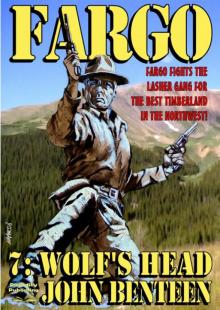 Wolf's Head (A Neal Fargo Adventure--Book Seven)
Wolf's Head (A Neal Fargo Adventure--Book Seven) Hell on Wheels (A Fargo Western #15)
Hell on Wheels (A Fargo Western #15) Sundance 6
Sundance 6 Valley of Skulls (Fargo Book 6)
Valley of Skulls (Fargo Book 6) Apache Raiders (A Fargo Western #4)
Apache Raiders (A Fargo Western #4) Sundance 15
Sundance 15 Sundance 13
Sundance 13 Sundance 3
Sundance 3 Fargo 12
Fargo 12 Sundance 12
Sundance 12 The Black Bulls (A Neal Fargo Adventure Book 10)
The Black Bulls (A Neal Fargo Adventure Book 10) The Sharpshooters (A Fargo Western Book 9)
The Sharpshooters (A Fargo Western Book 9) Panama Gold (A Neal Fargo Adventure #2)
Panama Gold (A Neal Fargo Adventure #2) Alaska Steel (A Neal Fargo Adventure #3)
Alaska Steel (A Neal Fargo Adventure #3) Sundance 7
Sundance 7 Overkill (Sundance #1)
Overkill (Sundance #1) Fargo 13
Fargo 13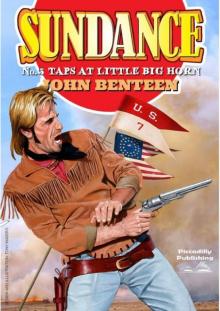 Sundance 5
Sundance 5 Gaylord's Badge
Gaylord's Badge Fargo (A Neal Fargo Adventure #1)
Fargo (A Neal Fargo Adventure #1) The Trail Ends at Hell
The Trail Ends at Hell Sundance 10
Sundance 10 Fargo 20
Fargo 20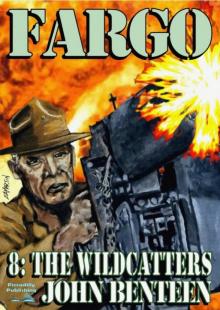 The Wildcatters
The Wildcatters The Phantom Gunman (A Neal Fargo Adventure. Book 11)
The Phantom Gunman (A Neal Fargo Adventure. Book 11) Sundance 8
Sundance 8 Sundance 2
Sundance 2 Fargo 18
Fargo 18 Sundance 9
Sundance 9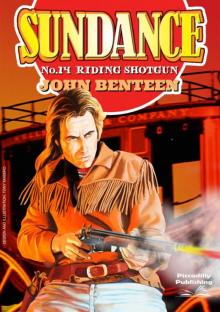 Sundance 14
Sundance 14 Sundance 4
Sundance 4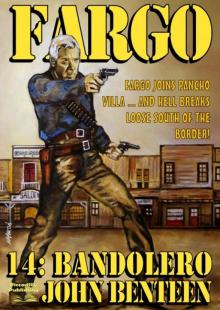 Bandolero (A Neal Fargo Adventure Boook 14)
Bandolero (A Neal Fargo Adventure Boook 14)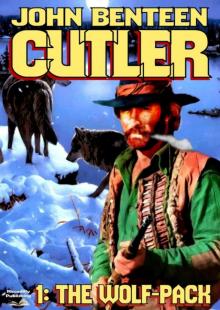 The Wolf Pack (Cutler #1)
The Wolf Pack (Cutler #1)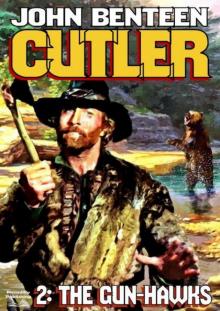 The Gunhawks (Cutler Western #2)
The Gunhawks (Cutler Western #2) Sundance 16
Sundance 16 Big Bend
Big Bend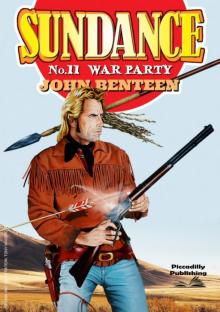 Sundance 11
Sundance 11 Massacre River (A Neal Fargo Western) #5
Massacre River (A Neal Fargo Western) #5 The Border Jumpers (A Fargo Western Book 16)
The Border Jumpers (A Fargo Western Book 16)